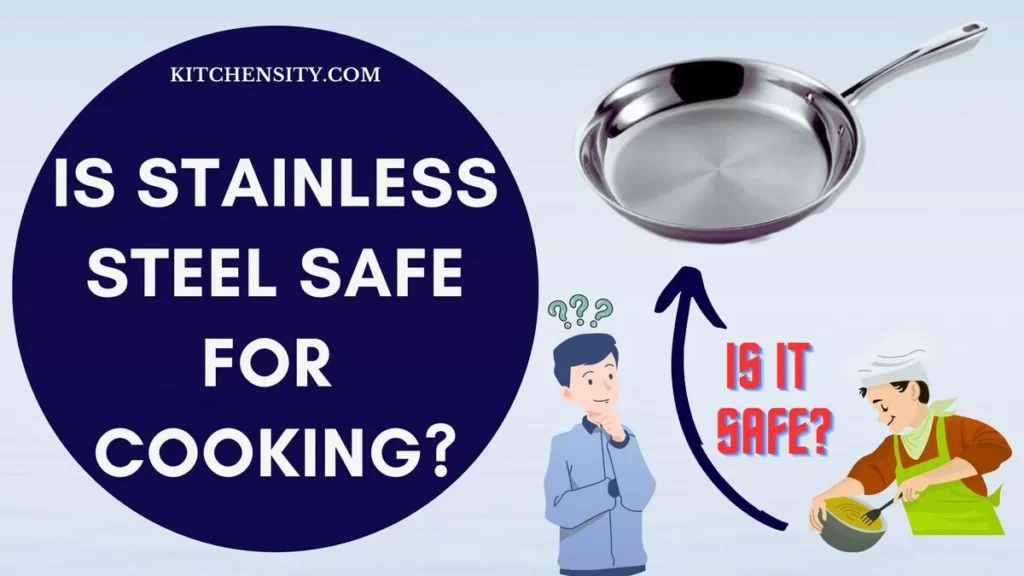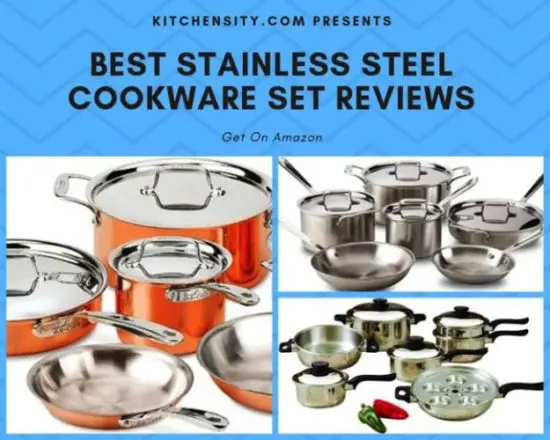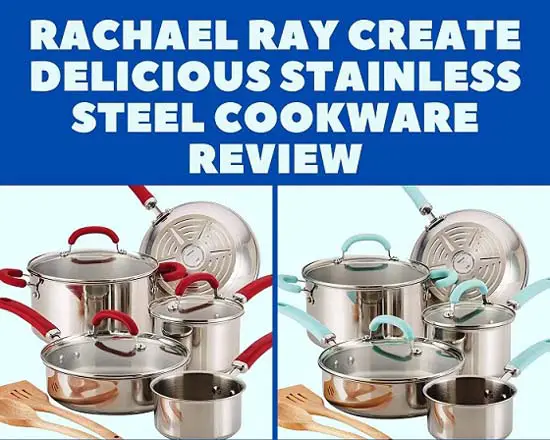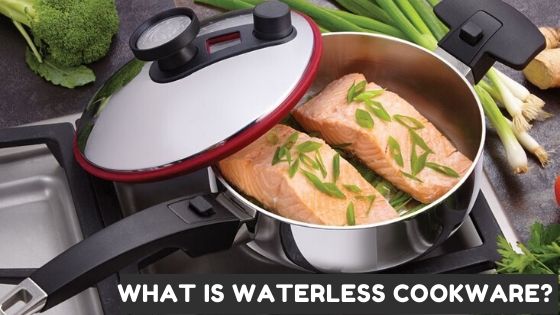Cookware selection is a crucial consideration for any kitchen, and stainless steel has become a popular choice for its durability and versatility.
However, as concerns about food safety and potential chemical leaching persist, the question arises: Is stainless steel safe for cooking?
In this article, we will delve into the properties of stainless steel cookware, explore its safety aspects, and address common misconceptions to help you make an informed decision about its suitability for your culinary needs.

Table of Contents
- 1 Is Stainless Steel Safe For Cooking?
- 2 Understanding Stainless Steel
- 3 Benefits Of Stainless Steel Cookware
- 4 Potential Health Concerns
- 5 Proper Use And Care Of Stainless Steel Cookware
- 6 Alternative Cookware Options
- 7 Addressing Common Misconceptions
- 8 Environmentally Friendly Aspects Of Stainless Steel Cookware
- 9 Stainless Steel Cookware Brands And Safety Standards
- 10 Is Stainless Steel Toxic To Humans?
- 11 What Foods Should Not Be Cooked In Stainless Steel?
- 12 Is Magnetic Stainless Steel Safe For Cooking?
- 13 Final Verdict
- 14 FAQs
- 14.1 Is Stainless Steel Toxic When Heated?
- 14.2 Do Chefs Cook With Stainless Steel?
- 14.3 Is Stainless Steel Cookware Dishwasher Safe?
- 14.4 Can I Use Metal Utensils With Stainless Steel Cookware?
- 14.5 Does Stainless Steel Cookware Work On Induction Cooktops?
- 14.6 How Do I Remove Stubborn Stains From Stainless Steel Cookware?
- 14.7 Is It Safe To Cook Acidic Foods In Stainless Steel Pots?
Is Stainless Steel Safe For Cooking?
Yes, stainless steel is safe for cooking. It is a non-reactive material that does not leach harmful substances into food during cooking. When used properly and maintained, stainless steel cookware is a reliable and popular choice for culinary endeavors.
Also Read – Ultimate Guide For Buying Stainless Steel Cookware
Understanding Stainless Steel
Stainless steel is a type of metal alloy that is widely used in various industries, including kitchenware and cookware. It is composed primarily of iron, carbon, and at least 10.5% chromium.
The addition of chromium gives stainless steel its unique property of being corrosion-resistant, making it highly desirable for cooking applications.
The term “stainless” in stainless steel refers to its ability to resist stains, rust, and corrosion, which makes it an excellent choice for kitchen utensils and appliances.
This alloy is known for its durability and longevity, making it a popular material for manufacturing high-quality cookware.
Also Read – Best Stainless Steel Cookware Without Aluminum
The Composition Of Stainless Steel Cookware
The primary components of stainless steel cookware are iron, carbon, and chromium. The presence of chromium is crucial as it imparts the remarkable resistance to corrosion and staining that makes stainless steel stand out.
- In general, stainless steel cookware contains a minimum of 10.5% chromium to ensure its non-corrosive nature.
- In addition to chromium, some stainless steel cookware may also include other elements like nickel and molybdenum.
- Nickel is often added to enhance the overall strength of the stainless steel and increase its resistance to rusting.
- Molybdenum, on the other hand, contributes to the alloy’s ability to withstand harsh environments and corrosive substances.
The grade most commonly used for stainless steel cookware is 18/8, which signifies its composition of 18% chromium and 8% nickel. This combination not only ensures the cookware’s durability but also provides it with an attractive and polished appearance.
The careful balance of these elements in the stainless steel composition gives cookware its unique qualities, making it a reliable, long-lasting, and safe option for everyday cooking needs.
When properly cared for and maintained, stainless steel cookware can serve as an indispensable kitchen companion for many years, bringing joy to countless cooking endeavors.
Also Read – Rachael Ray Create Delicious Stainless Steel Cookware Review
Benefits Of Stainless Steel Cookware
Stainless steel cookware is highly regarded and favored by both professional chefs and home cooks for several compelling reasons. Its numerous benefits make it a top choice for kitchenware.
Let’s explore some of the key advantages of using stainless steel cookware:
1. Durability And Longevity
- Stainless steel cookware is renowned for its exceptional durability, making it highly resistant to dents, scratches, and warping.
- It can withstand high temperatures and is less likely to chip or break compared to other materials.
- This robustness ensures that your stainless steel cookware will remain functional and intact for many years, even with regular use.
2. Even Heat Distribution
- One of the standout features of stainless steel cookware is its excellent heat distribution.
- It distributes heat evenly across its surface, preventing hot spots that could lead to uneven cooking.
- This consistent heat distribution ensures that your food cooks uniformly, enhancing the overall quality of your dishes.
You May Also Like: What is Waterless Cookware? How does it work?
3. Non-Reactive Properties
- Stainless steel is non-reactive to acidic or alkaline foods, meaning it won’t interact with ingredients during the cooking process.
- This is particularly advantageous when cooking dishes with tomatoes, citrus, or other acidic components, as it preserves the natural flavors and colors of the food without altering its taste.
4. Versatility In Cooking Methods
- Stainless steel cookware is highly versatile and compatible with various cooking methods.
- It can be used on gas, electric, and induction cooktops, as well as in ovens and broilers.
- Whether you’re searing, frying, sautéing, simmering, or baking, stainless steel cookware delivers reliable and consistent results.
5. Easy To Clean And Maintain
- Cleaning stainless steel cookware is a breeze.
- Its smooth and non-porous surface resists sticking, making it relatively easy to remove food residues.
- Hand washing with warm soapy water and a soft sponge is usually sufficient for regular maintenance.
- Additionally, many stainless steel cookware sets are dishwasher-safe for added convenience.
You May Also Like: How To Season Stainless Steel Pots And Pans?
6. Attractive Appearance
- Stainless steel cookware boasts a sleek and polished appearance that complements any kitchen decor.
- Its shiny surface not only adds a touch of elegance to your cooking space but also retains its luster over time, even with repeated use and cleaning.
7. Retains Heat
- Stainless steel has excellent heat retention properties, keeping your dishes warm even after they are removed from the heat source.
- This is particularly useful when serving meals at the table, as the food will stay hot for a more extended period.
8. Environmentally Friendly
- Stainless steel is considered an environmentally friendly material due to its recyclability.
- It can be recycled at the end of its life cycle, reducing waste and environmental impact.
- Additionally, its longevity and resistance to wear and tear mean that you won’t need to replace your stainless steel cookware frequently, further contributing to sustainability.
So, the benefits of stainless steel cookware, including its durability, even heat distribution, non-reactive properties, and versatility, make it a practical and reliable choice for any kitchen.
With proper care and maintenance, stainless steel cookware can become a valuable and long-lasting investment, enhancing your cooking experience and delighting your taste buds for years to come.
Also Read – Stainless Steel vs Nonstick vs Ceramic Cookware Set
Potential Health Concerns
While stainless steel cookware offers numerous advantages, it’s essential to be aware of potential health concerns associated with its usage. While generally safe, certain factors should be considered:
1. Nickel Content And Allergies
- Stainless steel cookware typically contains nickel, an element used to enhance the alloy’s strength and corrosion resistance.
- For most people, the small amounts of nickel present in stainless steel cookware pose no health risks.
- However, individuals with nickel allergies or sensitivities may experience skin reactions or other adverse effects.
- If you have a known nickel allergy, it’s advisable to exercise caution and consider alternative cookware options.
2. Chromium Leaching
- Under specific conditions, such as using stainless steel cookware in poor condition or exposing it to extremely high temperatures, there is a minimal risk of chromium leaching into food.
- Chromium is an essential trace element found in small amounts in many foods and is generally considered safe for consumption.
- However, prolonged exposure to high levels of chromium can be harmful.
- To minimize this risk, it’s essential to use stainless steel cookware properly, avoid overheating, and inspect for any signs of wear or damage.
In general, the health concerns associated with stainless steel cookware are minimal and affect only a small subset of the population with specific allergies or sensitivities.
For the vast majority of users, stainless steel cookware remains a safe and reliable choice for cooking needs. By following proper usage and maintenance guidelines, you can mitigate any potential risks and continue to enjoy the benefits of this versatile and durable kitchenware.
As with any cooking utensils, it’s always a good practice to be mindful of food preparation and handling, as well as to maintain your cookware in good condition to ensure the safety and well-being of you and your loved ones.
Also Read – Best Stainless Steel Cookware Under $100
Proper Use And Care Of Stainless Steel Cookware
To ensure the longevity and optimal performance of your stainless steel cookware, it’s essential to follow proper use and care guidelines. By doing so, you can maintain the cookware’s integrity and enjoy its benefits for many years. Here are some valuable tips:
- Preparing The Cookware:
- Before using your new stainless steel cookware for the first time, wash it thoroughly with warm, soapy water.
- This step helps remove any manufacturing residues and ensures that your cookware is clean and ready for use.
- Rinse it well and dry it with a soft cloth or towel.
- Cooking At The Right Temperature:
- Stainless steel cookware is designed to heat up quickly and evenly.
- When cooking, avoid using extremely high temperatures, as this can lead to discoloration and, in some cases, cause food to stick to the surface.
- Instead, use medium to medium-high heat settings for most cooking tasks.
- Using The Right Cooking Utensils:
- Stainless steel is a sturdy material, but using the right utensils can help preserve its smooth surface.
- Opt for wooden, silicone, or nylon utensils instead of metal ones to prevent scratching or damaging the cookware.
- Adding Oil Or Butter:
- To prevent food from sticking, add a small amount of oil or butter to the cookware before cooking.
- This is especially useful when preparing dishes that are prone to sticking, such as eggs or delicate fish.
- Avoiding Abrasive Cleaners:
- When cleaning your stainless steel cookware, avoid using harsh or abrasive cleaning agents or scrubbing pads.
- These can damage the cookware’s surface and leave scratches. Instead, opt for mild dish soap and a soft sponge or cloth to gently clean the cookware.
- Cleaning Immediately After Use:
- To make cleaning easier and maintain the cookware’s appearance, it’s best to clean stainless steel cookware immediately after use.
- Allow the cookware to cool slightly before washing it with warm soapy water.
- This will help prevent food residues from hardening and sticking to the surface.
- Removing Stubborn Stains:
- For stubborn stains or residue, create a paste using baking soda and warm water.
- Apply the paste to the affected areas, let it sit for a few minutes, and then gently scrub with a non-abrasive sponge.
- Rinse thoroughly and dry with a soft cloth.
- Regularly Checking For Wear And Tear:
- Inspect your stainless steel cookware regularly for any signs of wear and tear, such as scratches or dents.
- Replace any damaged pieces, as these can affect the cookware’s performance and may pose safety risks.
With these simple yet effective tips, you can ensure that your stainless steel cookware remains in excellent condition and continues to be a reliable and versatile companion in your kitchen.
Proper use and care will not only enhance its longevity but also contribute to consistently delicious and well-cooked meals for you and your loved ones.
Also Read – Carbon Steel Vs Stainless Steel Vs Cast Iron Pans
Alternative Cookware Options
If you have concerns about using stainless steel cookware, there are alternative options available.
- Cast Iron Cookware: Cast iron cookware is an excellent alternative known for its even heat distribution and natural non-stick properties. However, it requires regular seasoning and proper care to prevent rusting.
- Ceramic Cookware: Ceramic cookware is non-reactive and easy to clean. It is an excellent choice for those seeking a non-metallic alternative.
- Glass Cookware: Glass cookware is non-reactive and transparent, allowing you to monitor your food while cooking. However, it may not distribute heat as evenly as stainless steel or other materials.
Addressing Common Misconceptions
When it comes to stainless steel cookware, several misconceptions and myths have arisen over time. Let’s address some of the most common ones and clarify the facts:
1. Stainless Steel Vs. Nonstick Cookware
- Misconception: Nonstick cookware is always a better option than stainless steel cookware.
- Clarification:
- While nonstick cookware is convenient for certain tasks and requires less oil for cooking, it is not always superior to stainless steel.
- Nonstick coatings can wear off over time, especially with regular use and high-heat cooking.
- On the other hand, stainless steel cookware is highly durable and can withstand higher temperatures without compromising its performance.
- Additionally, stainless steel is more versatile, allowing you to use metal utensils and achieve excellent browning and searing.
Also Read – Are Gotham Steel Pans Oven-Safe?
2. Stainless Steel Vs. Aluminum Cookware
- Misconception: Aluminum cookware is better at conducting heat than stainless steel cookware.
- Clarification:
- Aluminum is indeed an excellent conductor of heat, but stainless steel cookware can also distribute heat evenly when it is properly constructed with a layered or bonded base.
- Many stainless steel cookware sets feature an aluminum or copper core, which enhances its heat distribution capabilities.
- Moreover, stainless steel is less reactive to acidic foods, making it a safer option for cooking such dishes compared to aluminum.
3. Stainless Steel Cookware Is Completely Non-Reactive
- Misconception: Stainless steel cookware is entirely non-reactive to all foods.
- Clarification:
- While stainless steel is generally non-reactive to most foods, highly acidic or alkaline ingredients, such as tomatoes or citrus fruits, can cause some interaction with the cookware.
- However, this reactivity is minimal and unlikely to affect the taste or safety of the food.
- For those with concerns, using higher-quality stainless steel with lower nickel content can further reduce the risk of any reaction.
Also Read – Hard-Anodized Vs Stainless Steel Cookware
4. Higher Nickel Content Is Always Better
- Misconception: Stainless steel cookware with higher nickel content is of superior quality.
- Clarification:
- The nickel content in stainless steel cookware serves a specific purpose, mainly to enhance the alloy’s strength and resistance to rusting.
- While higher nickel content may be beneficial for some applications, it is not the sole indicator of cookware quality.
- The grade most commonly used for stainless steel cookware is 18/8, which contains 18% chromium and 8% nickel.
- This composition strikes an ideal balance between durability, performance, and cost-effectiveness.
So, it’s essential to differentiate between common misconceptions and the actual properties of stainless steel cookware. While both nonstick and aluminum cookware have their advantages, stainless steel remains a durable, versatile, and safe choice for most cooking tasks.
By understanding the unique benefits of stainless steel and dispelling these misconceptions, you can confidently enjoy its exceptional performance and reliability in your kitchen.
Also Read – How To Clean Burnt Glass Pans?
Environmentally Friendly Aspects Of Stainless Steel Cookware
Stainless steel cookware offers several environmentally friendly features that make it a sustainable choice for conscientious consumers. Let’s explore some of the eco-friendly aspects of stainless steel cookware:
1. Recyclability And Sustainability
- Stainless steel is highly recyclable, making it an eco-friendly material choice.
- At the end of its long life cycle as cookware, it can be recycled into new products, reducing the demand for new raw materials.
- Recycling stainless steel helps conserve valuable resources and minimizes waste in landfills, contributing to a more sustainable and greener environment.
2. Energy Efficiency
- Stainless steel cookware’s excellent heat conductivity and even heat distribution contribute to energy efficiency during cooking.
- It requires less time and energy to achieve the desired cooking temperature, leading to reduced energy consumption.
- Using energy-efficient cookware helps decrease overall energy usage, which is beneficial for the environment and can potentially lower utility bills.
Also Read – Why Do Metal Handles Of Pans Get Hot?
3. Durability And Longevity
- Stainless steel cookware is renowned for its durability and longevity.
- Unlike some other materials that may wear out or degrade over time, stainless steel is resistant to dents, scratches, and corrosion.
- Its robust construction ensures that it can withstand frequent use and cleaning without losing its functionality or appearance.
- Choosing long-lasting cookware reduces the need for frequent replacements, which in turn reduces waste and lessens the burden on natural resources.
4. Reduced Chemical Use
- Unlike nonstick cookware that often requires the use of coatings containing potentially harmful chemicals, stainless steel cookware does not rely on such coatings.
- It is a non-reactive material, meaning it does not release harmful substances into the food during cooking.
- By using stainless steel cookware, you can avoid potential exposure to harmful chemicals found in some nonstick coatings, contributing to a healthier and safer cooking environment.
5. Minimal Waste Generation
- Stainless steel cookware is designed to be sturdy and resistant to wear and tear.
- This longevity ensures that the cookware remains in use for an extended period, reducing the generation of waste.
- Additionally, stainless steel is easy to clean, and its non-porous surface prevents food residues from sticking, which further minimizes waste during cleaning and maintenance.
Also Read – Best Pans For Searing Fish
6. Reduced Packaging
- Stainless steel cookware often comes with minimal or eco-friendly packaging.
- Unlike some other kitchenware that may be packaged with excessive plastic or non-recyclable materials, stainless steel cookware manufacturers often opt for more sustainable packaging options.
- This reduces the environmental impact associated with product packaging and disposal.
Stainless Steel Cookware Brands And Safety Standards
When choosing stainless steel cookware, it’s essential to opt for reputable brands that adhere to safety standards and regulations. Here are some well-known stainless steel cookware brands and the safety aspects to consider:
1. All-Clad
- All-Clad is a renowned brand known for its high-quality stainless steel cookware.
- They use 18/10 stainless steel, which contains 18% chromium and 10% nickel, ensuring durability, excellent performance, and corrosion resistance.
- All-Clad’s cookware is manufactured with precision and attention to detail, adhering to strict safety standards.
2. Cuisinart
- Cuisinart offers a wide range of stainless steel cookware collections designed for both home cooks and professional chefs.
- They use 18/0 stainless steel in some of their lines, which contains 18% chromium and no nickel.
- This makes the cookware nickel-free, making it suitable for individuals with nickel allergies.
3. Calphalon
- Calphalon produces stainless steel cookware with layered construction, including an aluminum core for enhanced heat distribution.
- Their Tri-Ply and Signature collections are well-regarded for their performance and durability.
- Calphalon follows safety guidelines to ensure its cookware meets industry standards.
Also Read – Hard Anodized Vs Cast Iron Cookware
4. Viking Culinary
- Viking Culinary is a trusted brand known for its professional-grade stainless steel cookware.
- Their cookware sets are often made with 18/10 stainless steel, providing superior corrosion resistance and longevity.
- Viking Culinary focuses on safety and quality in its manufacturing process.
5. Le Creuset
- While primarily known for its colorful enameled cast iron cookware, Le Creuset also offers a selection of stainless steel cookware.
- Their Tri-Ply Stainless Steel collection features durable construction and adheres to safety standards to provide reliable performance.
Also Read – What Happens When You Put An Aluminum Pan In The Microwave?
6. Safety Standards
- When choosing stainless steel cookware, look for products that meet safety standards and regulations, such as those set by the Food and Drug Administration (FDA) in the United States.
- These standards ensure that the materials used in the cookware are safe for cooking and do not leach harmful substances into the food.
7. Nickel-Free Options
- If you have concerns about nickel allergies or sensitivities, consider opting for stainless steel cookware labeled as “nickel-free” or made with 18/0 stainless steel.
- This grade contains no nickel while still providing the benefits of stainless steel cookware.
Also Read – Hard Anodized Vs Titanium Cookware
Is Stainless Steel Toxic To Humans?
No, stainless steel is not toxic to humans when used in normal cooking and food preparation conditions. Stainless steel is widely regarded as a safe and non-toxic material for cookware and kitchen utensils. It is composed of iron, carbon, and a minimum of 10.5% chromium, which gives it its corrosion-resistant properties.
The chromium in stainless steel forms a thin, protective layer on the surface of the cookware, preventing it from reacting with food and inhibiting any harmful substances from leaching into the food during cooking.
However, it’s important to note that some individuals may have specific allergies or sensitivities to nickel, which is also present in stainless steel cookware. The amount of nickel in stainless steel cookware is relatively small, and for the vast majority of people, it poses no health risks.
But for those with nickel allergies, it may be advisable to consider nickel-free stainless steel cookware or alternative cookware materials to avoid potential allergic reactions.
In general, when used as intended and cared for properly, stainless steel cookware is considered safe and a popular choice for cooking due to its durability, even heat distribution, and non-reactive properties.
As with any kitchenware, it’s always essential to follow the manufacturer’s instructions for proper use and maintenance to ensure safe and enjoyable cooking experiences.
Also Read – Ceramic Cookware Vs Aluminum Cookware
What Foods Should Not Be Cooked In Stainless Steel?
While stainless steel cookware is generally safe for cooking a wide variety of foods, some types of dishes may not be ideal to cook in stainless steel due to their characteristics or potential to react with the cookware’s surface.
Here are some examples of foods that may not be best suited for stainless steel cooking:
1. Salty or Acidic Foods
- Highly salty or acidic foods, such as tomato-based dishes, citrus fruits, and vinegar-heavy recipes, may cause a reaction with the stainless steel surface.
- This can result in a metallic taste or discoloration of the food.
- While stainless steel is generally non-reactive to most foods, it’s best to avoid cooking highly acidic or salty dishes for extended periods in stainless steel cookware.
2. Delicate Fish and Seafood
- Delicate fish and seafood, like flaky white fish or tender shellfish, may tend to stick to the surface of stainless steel cookware, especially if not properly seasoned or oiled.
- Nonstick cookware or options with a ceramic coating may be better choices for cooking delicate fish to prevent sticking and ensure easy removal from the cookware.
Also Read – Why Is Cast Iron Pan Sticky After Seasoning?
3. Foods Requiring Precise Temperature Control
- Stainless steel cookware does not have the same nonstick properties as certain other materials.
- Therefore, cooking dishes that require precise temperature control and careful flipping or tossing, such as omelets or delicate crepes, may be more challenging in stainless steel cookware.
- For such dishes, nonstick or well-seasoned cast iron cookware may provide better results.
4. Sugary Foods
- Foods with high sugar content, such as caramel or syrup-based recipes, may caramelize and stick to the surface of stainless steel cookware, making them challenging to clean.
- It’s best to use alternative cookware with nonstick properties for such recipes to avoid a sticky mess.
5. Foods That May Cause Strong Odors
- Stainless steel cookware can absorb strong odors from certain foods.
- Cooking pungent or strong-smelling dishes, such as curry or dishes with heavy spices, may leave residual odors in the cookware even after cleaning.
- In such cases, consider using designated cookware for these types of recipes to prevent cross-flavoring.
Also Read – Titanium Coating Vs Ceramic Coating Pan
Is Magnetic Stainless Steel Safe For Cooking?
Yes, magnetic stainless steel is safe for cooking. Many high-quality stainless steel cookware sets are made from magnetic stainless steel, which is known for its excellent durability and heat-conducting properties.
- Magnetic stainless steel is typically made from a combination of iron, carbon, and chromium, with nickel added to enhance its magnetic properties.
- The addition of nickel does not affect the safety of the cookware, as it is present in very small amounts and is generally well-tolerated by most individuals.
Stainless steel cookware with magnetic properties is compatible with induction cooktops, which rely on magnetic fields to generate heat directly in the cookware. This makes magnetic stainless steel cookware highly efficient for induction cooking, as it ensures even heat distribution and rapid heat transfer.
The magnetic properties of stainless steel do not impact the safety or quality of the food being cooked. Like regular stainless steel cookware, magnetic stainless steel is non-reactive and does not leach harmful substances into the food during cooking.
Overall, magnetic stainless steel cookware is a safe and reliable choice for cooking and is widely used in both home kitchens and professional culinary settings.
It offers the benefits of durability, even heat distribution, and compatibility with induction cooktops, making it a versatile and practical option for a variety of cooking needs.
Also Read – What To Look For When Buying Non-Stick Cookware?
Final Verdict
So, stainless steel is generally considered safe for cooking and offers numerous benefits that make it a popular choice among chefs and home cooks alike.
Its unique composition of iron, carbon, and chromium provides excellent durability, even heat distribution, and corrosion resistance.
While stainless steel cookware contains small amounts of nickel, which may pose concerns for individuals with nickel allergies or sensitivities, the overall risk is low for the majority of users.
Additionally, some manufacturers offer nickel-free options, making stainless steel cookware suitable for those with specific sensitivities.
Proper use and care of stainless steel cookware are essential for ensuring its safety and longevity. Cooking at the right temperature, using the appropriate utensils, and cleaning the cookware immediately after use are essential practices to maintain its performance and appearance.
Stainless steel cookware is non-reactive to acidic and alkaline foods, preserving the natural flavors of ingredients during cooking. Its versatility allows for various cooking methods on different heat sources, enhancing its value in the kitchen.
While there have been concerns about potential chromium leaching, these risks are minimal and can be mitigated through responsible usage and proper maintenance.
Furthermore, stainless steel cookware boasts environmentally friendly aspects, such as recyclability, energy efficiency, and reduced waste generation, making it a sustainable choice for eco-conscious individuals.
Also Read – Do Aluminum Pans Work On Induction?
FAQs
-
Is Stainless Steel Toxic When Heated?
No, stainless steel is not toxic when heated. It is a safe material for cooking due to its non-reactive properties.
-
Do Chefs Cook With Stainless Steel?
Yes, many chefs cook with stainless steel cookware for its durability, even heat distribution, and corrosion resistance.
-
Is Stainless Steel Cookware Dishwasher Safe?
Yes, most stainless steel cookware is dishwasher safe. However, hand washing is recommended to maintain its appearance and longevity.
-
Can I Use Metal Utensils With Stainless Steel Cookware?
Yes, stainless steel cookware is compatible with metal utensils, as it is highly durable and resistant to scratches.
-
Does Stainless Steel Cookware Work On Induction Cooktops?
Yes, many stainless steel cookware sets are designed to be compatible with induction cooktops.
-
How Do I Remove Stubborn Stains From Stainless Steel Cookware?
You can remove stains by soaking the cookware in a mixture of baking soda and warm water, then scrubbing gently with a non-abrasive sponge.
-
Is It Safe To Cook Acidic Foods In Stainless Steel Pots?
Yes, stainless steel is non-reactive to acidic foods, making it safe to cook such dishes.
Katrina Smith is a seasoned expert with over 25 years of experience in all things related to cooking and the kitchen. As an avid cook and kitchen enthusiast, she is passionate about sharing her knowledge and expertise on cookware, kitchen appliances, kitchen tips, and kitchen staples.
Through her articles and reviews, Katrina aims to inspire and help others improve their cooking skills, experiment with different ingredients, and invest in quality cookware and appliances.






![Buying Stainless Steel Cookware [Ultimate Guide With 13 Major Factors] 8 Buying Stainless Steel Cookware - An Ultimate Guide](https://www.kitchensity.com/wp-content/uploads/2023/07/What-To-Look-For-When-Buying-Stainless-Steel-Cookware-1024x576.webp)